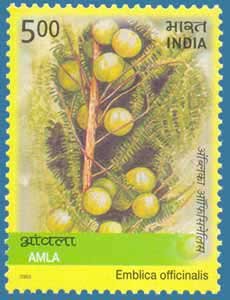Amla (Emblica officinalis)

Technical Data
| Stamp Set | Indian Medicinal Plants |
|---|---|
| Date of Issue | April 7, 2003 |
| Denomination | Rs. 5 |
| Perforation | comb 13 x 13¼ |
| Printer | Calcutta Security Printers Ltd |
| Watermark | No Watermark |
| Colors | Multicolor |
| Catalog Codes |
Michel IN 1957 Stamp Number IN 2002d Yvert et Tellier IN 1721 Stanley Gibbons IN 2125 WADP Numbering System - WNS IN013.03 |
| Themes | Plants (Flora) |
Table of Contents
Commemorative Stamp Set: Amla (Emblica officinalis)
Design Elements:
- Central Image: The Amla fruit, with its round green shape, depicted in various stages of ripeness.
- Botanical Illustration: A detailed illustration showcasing the Amla tree, branches, and its fruit in cross-section, highlighting its internal structure.
- Text: The scientific name Emblica officinalis and the common name “Amla” written in a traditional font.
- Background: A faint backdrop of Indian forests where Amla naturally grows, intertwined with ancient Ayurvedic texts.
- Border: A decorative design inspired by ancient Indian art and Ayurveda scrolls.
Cultural and Historical Significance:
- Ayurvedic Superfood: Amla has been a staple in Indian Ayurvedic medicine for centuries, revered for its high Vitamin C content and healing properties.
- Cultural Symbolism: Considered a sacred tree in Indian culture, Amla is linked to health, longevity, and spiritual well-being.
- Historical Usage: Used in ancient medicine to treat a wide variety of ailments, from digestive issues to boosting immunity and enhancing skin health.
Usage:
- Issued to Celebrate: The rich history of Amla in Indian medicine and culture, along with its increasing global popularity as a health supplement.
- Special Edition: Part of a series commemorating important Ayurvedic plants that have shaped India’s health practices.
- Postage: Used for domestic and international mail, ideal for promoting India’s cultural heritage and Ayurvedic practices.
Importance of the Commemorative Stamp Set:
- Promotion of Indigenous Knowledge: Showcases Amla’s contribution to Indian traditional medicine and its role in modern health practices.
- Educational Value: Informs the public about the numerous health benefits of Amla, including its use as a powerful antioxidant and immune booster.
- Cultural Preservation: Honors the deep connection between nature and Indian medicinal traditions.
Example of the Stamp Design:
A beautifully rendered Amla tree standing tall, with several fruits hanging from the branches. Below the tree, an open Ayurvedic scroll features ancient writings about Amla’s health benefits. The fruits are depicted in various shades of green and yellow, signifying their ripeness, and a cross-section of the fruit shows its seed and internal structure.
The Commemorative Stamp Set Might Include:
- Amla: The central focus of the set, with a detailed design highlighting its medicinal properties.
- Other Ayurvedic Herbs: Like Ashwagandha, Brahmi, and Neem, to create a collection of stamps that celebrates India’s vast herbal wealth.
Significance:
- Global Awareness of Ayurvedic Health: Promotes the widespread use and knowledge of Amla as a superfood and a key element of India’s natural medicine.
- Cultural Pride and Heritage: Reinforces the significance of India’s Ayurvedic traditions and the role Amla plays in promoting health and longevity worldwide.
